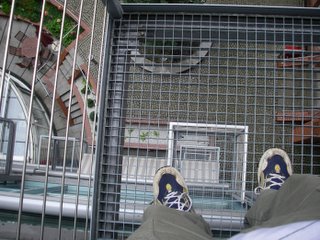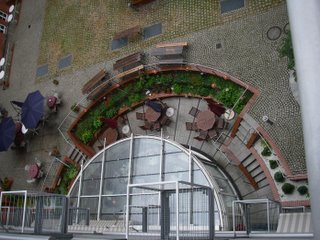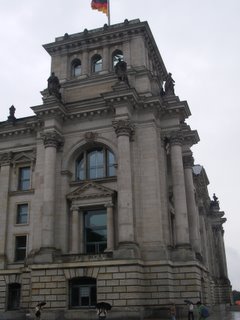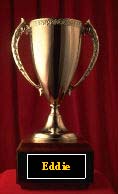Aye. It's 2AM and I'm finished. At last. That was the last one from my R&R. For thse who haven't been tuning in recently, you may have to go back and search the archives. I've been blogging up a storm - which means most of these posts have scrolled quickly into the archives, (in less than a week). I think the maximum your browser will display is usually ten posts (the most recent additions) - and I've done about 24 in ten days, so if you've been gone awhile - start digging.
Now hopefully, I can resume photo-blogging Baghdad.
All the Best,
-MG
Monday, September 25, 2006
Bahrain
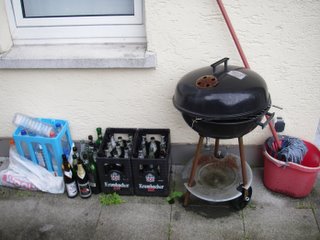
This is the last one of joe's back balcony. Bucket, mop, rusty grill, 29 empty beer bottles.
Good Trip.
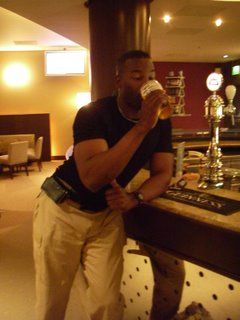
Flight Back: These are some of the guys I flew with to Germany. Then 15 days later, there they were again - to accompany me back to Kuwait via Bahrain.
This is Chief (WO3) Freeman. Downing it in one. Bahrain has drinks. One of two countries in the muslim middle east. But the clock was running out. Here, the Chief and I downed two or three in about 40 minutes.
Michael Freeman had just a few months left to go in his tour, whilst I was just starting mine.
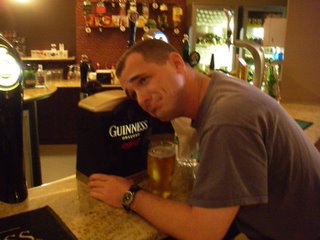
Tearful Goodbyes. How lucky was I that Guinness was waiting there in the Sky-bar to see me off?
Guinness had to stay here, in civilisation. (Well, a mock-up of civilisation, anyway). I had to return to duty. Building sand castles at high-tide.
Parting is such sweet sorrow. Fare thee well, Guinness . . . We'll always have Sheik Ali Malouf Hassan Rubaidi Alaladh Jubari Mohammed Bint Sultan Abu Saleef Mustapha Achmed Al Sadiqi International Airport.

SSG Lissa. Lissa's a helicopter mechanic from Minnesota, stationed in Afghanistan. He rendez-voused with his wife in Europe for a trip around the block. He had about 4 months to go in his tour.

"Gloom, despair and agony on me,
Deep, dark depression, excessive misery.
If it weren't for bad luck I'd have no luck at all,
Gloom, despair and agony on me."
Self-pity gets you nowhere, and if you haven't learned that by the time you enlist, you will.
One of the curious things about military life, which draws numbers from every single walk of life - is that you're never suffering alone, (which is a different kind of trial). You're together, bound by hardship. The guy next to you might not have anything in common with you. But he was there. In that proud memory that you grow fonder of with time, as its singularity uncoils through the mind-years. If you could have chosen, you might have picked your buddies or blood relatives to stand with you, to wile away the bored hours that stretch into months. But they weren't there. We were. We "happy few".
Joe's Apartment

This is Sweizer Strasse (Swiss Street) in Frankfurt, which Joe's apartment (now formerly Joe's apartment) fronts. This is the view from his front balcony looking left.

Front View. One of the many little sidewalk cafes in Frankfurt. This one's called the "Taj Mahal", an Indian/Italian culinary fusion run by a friendly immigrant family from India. We ate here a couple of times. They've got a great Chicken curry Pizza. Ah, what I would give now . . . Indian and Italian - how long has the world waited for that !?

This is the view looking right. More cafes, bars, commerce. Lithe, platinum Blond, 6 ft. German Amazons are frequently seen strolling, shopping, cavorting on Sweisser Strasse.
There's a tram, an underground, "public" bicycles that are remotely unlocked via cellphone. A River walk, music, and beer. Breezy walks, warm sunshine, cool breezes. Peace. All very swell. All not to be seen in Baghdad for at least another thousand years.
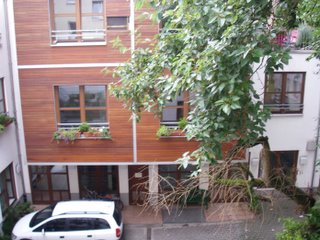
This is Joe's back balcony, much more accomodating - about 25' by 10' - that opens to the sunshine. This is the courtyard behind in which there's a small primary, or pre-school, where "kinders" are regularly heard laughing or playing out in the courtyard.

This is the rest of the back-patio. Great for hangover-recovery.
Sunday, September 24, 2006
The Wall

From Checkpoint Charlie, I walked a distance to a point on the map where there's a section of wall left standing. (near Potsdamer Platz, if memory serves). And this is it. That's all it was, (the wall itself). About three and a half inches thick, reinforced concrete. It rose, in sections, to about nine feet high where it was capped by a cylinder of concrete that fit over the ends, linking them together.
This "all it was" was augmented by guard towers, dog patrols, searchlights, barbed wire, fences, barriers, mines, booby traps, and a rapid reaction force - 24 hours a day. There was a hundred foot section inside the wall, (between an inner ring of fences and barbed wire - and the wall itself) known as the "death strip". Here was a free-fire zone with an easy line of sight for GDR guards to shoot their own people.
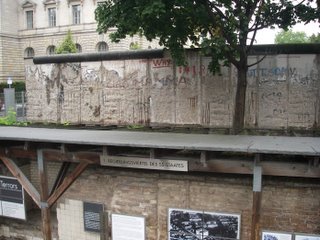 Behind this section of wall, as it turns out, was the former Gestapo headquarters. This is probably the reason this section was preserved - the confluence of both the 20th century's totalitarian nightmares. A developer and city planners want to build a museum here called "The Topography of Terror." But its tied up in a land and funding dispute. Nevertheless, as with the Checkpoint, vistors can gaze at many placards and weather-proof billboards out in the open, listen to push-button recordings of Class-A war criminals answering charges at Nuremburg, (with translation into English), and the like. most haunting were the photographs and entry records (the Gestapo were exceptional record-keepers) of ordinary Germans and Jews who disappeared here. Photo graphs that hung in front of you and were suspended on wires above, blown up to about a 6 by 4 foot portrait. Mug-shots for such crimes as "attending a labor meeting", and "associating with known Jewish subversive agents," and such. You can imagine the rest. What staggers is that the Gestapo felt the need to lie, in their own internal records.
Behind this section of wall, as it turns out, was the former Gestapo headquarters. This is probably the reason this section was preserved - the confluence of both the 20th century's totalitarian nightmares. A developer and city planners want to build a museum here called "The Topography of Terror." But its tied up in a land and funding dispute. Nevertheless, as with the Checkpoint, vistors can gaze at many placards and weather-proof billboards out in the open, listen to push-button recordings of Class-A war criminals answering charges at Nuremburg, (with translation into English), and the like. most haunting were the photographs and entry records (the Gestapo were exceptional record-keepers) of ordinary Germans and Jews who disappeared here. Photo graphs that hung in front of you and were suspended on wires above, blown up to about a 6 by 4 foot portrait. Mug-shots for such crimes as "attending a labor meeting", and "associating with known Jewish subversive agents," and such. You can imagine the rest. What staggers is that the Gestapo felt the need to lie, in their own internal records. 
And here, on a neighboring building, was this relief. Time-honored German craftsmanship. Clockmaking. Perhaps a father and child. Or Guildsman and apprentice. It brought back to me my first impression of Baghdad - peaceful, serene. There's no evil in the land. No crazy in the water. It criss-crosses every human heart - as Solzhenitzen said. Like the Berlin wall, only mobile. Retreating and advancing across the heart's topography. Unless that's what they meant, there's no "topography" to terror.

And here's the backside, facing Potsdamer Platz. The heart of Berlin nightlife - the most renowned in Europe in the 20's and 30's. It was also a large, open-air plaza. The nerve center of the Third Reich was built all around it, which guaranteed its destruction, and the Cold War divided it into.
It has since undergone a renewal, restoring it to a new shine, (and height! The buildings around it look almost like Manhattan)
Checkpoint Charlie (Pt. 2)
 On the morning of the 28th of October, 1961, the sun rose over this scene: Soviet Tanks faced US ones across checkpoint Charlie. In a tense standoff that foreshadowed much of what was to come, the West demonstrated its resolve. And didn't blink.
On the morning of the 28th of October, 1961, the sun rose over this scene: Soviet Tanks faced US ones across checkpoint Charlie. In a tense standoff that foreshadowed much of what was to come, the West demonstrated its resolve. And didn't blink. Tensions reached this level because the Soviets began restricting passage to and from East Berlin, harrassing and detaining diplomats, and shutting off traffic through other checkpoints. The wall had been completed a scant two months before.
The Soviets had to erect barriers and barbed wire, poles that would stop speeding East Germans from crashing through to freedom. All that ever stood on the US side was this humble wooden shack.
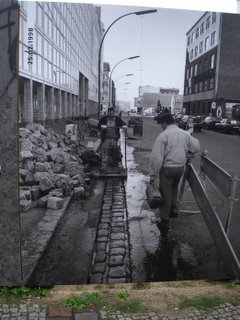
[Giant, life-sized billboards like these run a good 100 meters in all directions away from Checkpoint Charlie, telling it story.]
Good Riddance: This picture of a picture shows the wall finally being torn down, and in its place a two-row brick line that marks where the wall once stood, which runs uninterrupted along, across and through modern united Berlin - so that noone forgets.
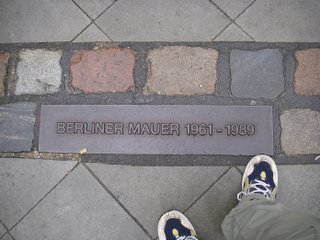
My sneaks, and the marker found at various points along its length: "Berliner Mauer 1961-1989."

This one brought me to tears, and it always will.
"Nowhere else is the division of east and west more visible than at Checkpoint Charlie. Here, a single wall cut through an entire city. And it was here that the people of the United States of America bore testimony, in impressive fashion, to their unconditional commitment to fundamental values such as human rights, democracy and freedom. Over the 28 years of its existence, Checkpoint Charlie was visited by many statesmen, giving the people hope that their wish for freedom and peace would be fulfilled.
It was here that Ronald Reagan realised the scale of the situation and resolved to tear down the Iron Curtain."
That's damn right.
I didn't think they'd mention the Gipper . . . but they did. History is having its say, and the din of the Anti-Reagan ideologues is about as audible now as a mosquito's wings flapping. This bit makes me misty-eyed because it contains gratitude. Which is all we've ever asked for.
Checkpoint Charlie
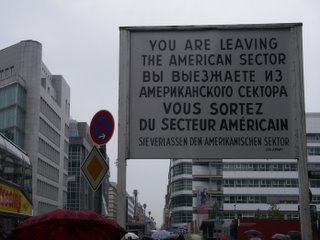
I broke this one up into two posts owing to its importance. This is Checkpoint Charlie, "Ground zero" during the Cold War. This was the place of maximum drama of that war, where two diametrically opposed systems eyed one another from the fall of Berlin.
This sign which everyone who crossed saw, has been preserved, (in perpetuity - one hopes). You are looking from the West into the newly revitalized East. When the gig was up, and East Berliners started fleeing en masse for the West, the Soviets put up the wall where some 169 people were shot on sight. Guards were given bonuses and extra vacation for such murders.

Here is a typical American farmboy, in the uniform of the period, who guarded this post for all those years in that "Long, twilight struggle".
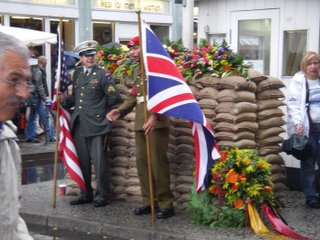
Here are actors, (I have to assume - no decorum or military bearing) representing the UK and the US. Allies which, not for the first time, (nor the last time), found themselves on the right side of history, and not coincidentally.
SCOREBOARD:
US/UK Alliance - 6
Evil - 0

Here is their counterpart, the farmboy from the Urals. This view is the flipside of the previous billboard, looking West. I hope he's well and had many children. They're free now.
The View
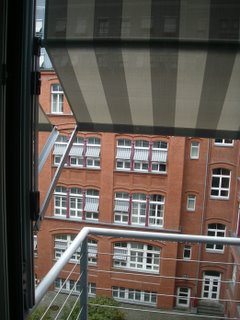
This is the awning leading to the balcony. It was automated! And would roll out on cue in the morning, fully extended. Retracting late in the afternoon.
This is the view directly left of the balcony across the courtyard, and other identical balconies on the fourth floor.
My sneaks again. This is the view straight down, and the feeling that you're suspended in air.
This is the lovely little Hotel courtyard bar and restaurant, neatly landscaped, immaculately maintained. There was a light drizzle in the air, as I surmise there often is, so the glass semicircular enclosure is where one eats brekfats on mornings like this. And it was superb! Bagels, cheeses, hams, fruits and Nutella! (I'm back in the Nutella club after this trip.)
And here's the courtyard, where you can just see the kinder milling about and yammering.
Accomodations

For about 100 bucks, with tax, this is what you get in East Berlin. This hotel was formerly an elementary school, and the shape and environs were preserved intact. The block and neighborhood this hotel was in was interspersed with new businesses and hotels and a mall. Mixed in with this were condemned buildings and apartment blocks that had one or two die-hard tenants that refused the Gov. buyout and move. Over time, these will fold and developers will transform the former Soviet eyesores into attractive improvements like this one.
This is the bed, and the bathroom - visible through the glass.

The bathroom, (the other side). These fixtures and accomodations are all modern and new.

Desk, or writing table. (You can smell the newness, yes?)
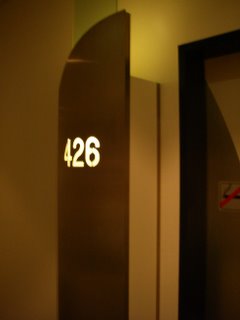
The room number, reminiscent of Star Trek. Or perhaps a mocking look back at something more sinister.
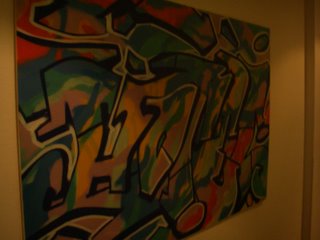
This was the art work on the walls in the hallway, (there were many more) evoking the graffitti on "thee wall."
The Reichstag
Aah, Berlin
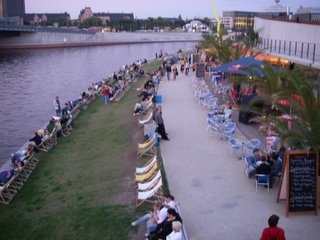
Capitol Beach! This is the scene just outside the new showpiece mega-station in formerly East Berlin. East is West and West is East. Griping I heard at the time, and in articles since - is that West Berliners are quite anxious and envious over the rapid advance of East Berlin. When the wall came down, virtually everything was up for sale. And with no development and improvement during the Soviet period - East Berlin was a blank canvas for planners and developers to re-invent. The new station (Hanau Banhoff?) has most of the Berlin traffic routed through it now - showcasing the change and robbing many West Berlin vendors of their tourist patronage. My hotel (in East Berlin) was 4-star, (as you'll see) and relatively cheap. "Go East Berlin!", I say.
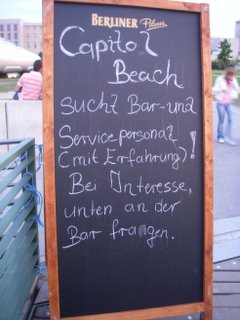
I found Berlin to be a city like no other, with most everyone English-capable and very warm, friendly and cosmopolitan. Its very ancient/modern like London, and like London - a spirit of fun prevails. Here's the menu at the Capitol Beach.

Here's a piece of children-friendly, easily understood, and functional artwork leftover from the World Cup, recently concluded.
The River Valley, (Revisited)
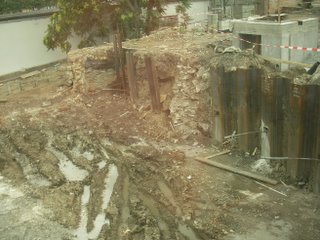 Back through the River Valley for a fourth time, I remembered to shoot some of the spots I'd missed. This time from Vienna, through Prague, and onto Berlin. This shot captures my awed sense of history, which the soil of Europe is replete with.
Back through the River Valley for a fourth time, I remembered to shoot some of the spots I'd missed. This time from Vienna, through Prague, and onto Berlin. This shot captures my awed sense of history, which the soil of Europe is replete with.This was an ordinary stop. I don't even remember the town - given that all of them were so post-card picturesque. What a wonder it would be to spend Christmas here. This stop was otherwise unremarkable but for this construction project that reveals a wall or foundation beneath its surface, (in center of photo, between the corrugated metal sheets). Its contruction, (stone size and arrangement) indicates significant age. When was this built? Was it a Foundation? A Wall? A large manor home? When was it in use? When did it fall into disrepair/disuse? With so much history, Europeans have the luxury of ignoring it.
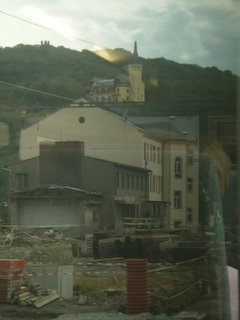
Look at this yellow hotel, (probably formerly a manor home), up on a hill on the far side. How'd you like to spend a summer here? A Christmas?

Here are the cliffs, and the homes and hotels built into its side and in its shade.
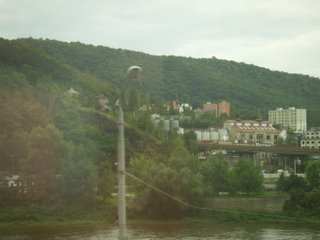
And this is the only photo I have that captures the very ugly and very out-of-place Stalinist housing blocks and edifices. Mercifully, generally well outside the heart of the town or city, but generally also up above and in the hills, looming over it.
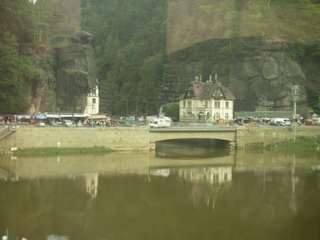
This is a particularly picturesque place where the River diverts. A meeting place and trading hub today, as it must have been for millenia.
I must have a beer in that pub on the right.
Saturday, September 23, 2006
Churches

Not yet replaced by mosques. Churches. Grand churches. This is St Stephen's. Ground Zero for Vienna, stading since . . . I'm not sure, but it was the center of town back in the ancient mock-ups in the museum. This place is still an active Catholic church, and is simply humbling inside, where an air of reverance and quietude prevails.
Here is her roof and towering spire. You can just make out the double-headed eagles - symbol of the Austrian state - tiled in mosaic on the roof.
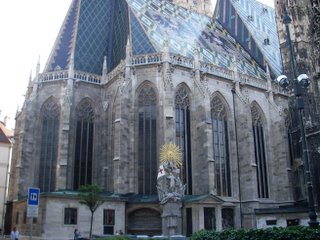
Here in closer relief, along with her structure and buttresses and a statue of what must be St. Stephen.

This is another church. (I will have to research it and update/edit this post - I don't have the name.)
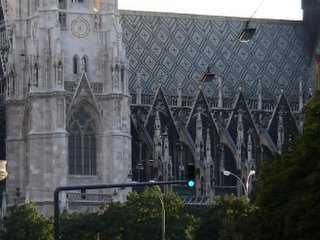
And here is her roof and buttresses . . . Stunning.
I also took the elevator (installed for renovationist work along with at least ten stories of scaffolding) inside Karskirche (Karl's "kirk" - or church). An unrivalled example of Baroque architecture and beauty. The frescoes inside approach the beauty and majesty of the Sistine Chapel, surely - though I've never been.
Alas, again, I evidently took no pictures. Must have been entranced. (or shaking in my boots from the height).

This is a crucifix on a wall (the same wall as the graffitti in the previous post, which runs for a good distance) near my hotel. Glad to see HE's still here.
Wiener Shnitzel (Miscellaneous)
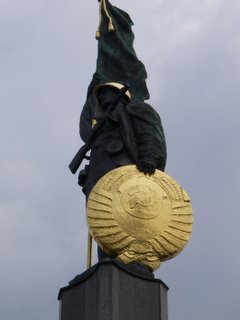 Wiener Shnitzel. I finally know what this means. Wiener - of Vienna. Shnitzel - a tenderized, (pulverized), breaded pork chop. Dee-lish. And very un-Islamic.
Wiener Shnitzel. I finally know what this means. Wiener - of Vienna. Shnitzel - a tenderized, (pulverized), breaded pork chop. Dee-lish. And very un-Islamic. Anyway, on to cruel irony. A very disquieting irony emerged on OUR side of the iron curtain. In Vienna and Berlin I found monuments to the Red Army. Monuments to the "liberator". This was by far the largest and most guilded. Now, I have no problem with a nation honoring its war-dead. Especially the losing side. The Yasukuni shrine in Japan, Confederate memorials in every single Southern town. I think its necessary - to PREVENT revival of that which was rightly defeated. But here we have a different animal. The sacrifice of the Red Army indeed drove the Nazis out, but it was Churchill and Roosevelt that LIBERATED them at Yalta, whilst consigning their neighbors to Soviet penury and Stalinite TERROR, starvation and death. How this could have escaped the very FORTUNATE denizens of Berlin and Vienna (and presumably others), escapes me.

My own wish is that we'd unleashed a secret weapon we had called "George S Patton" on the ragtag Red Army (which we'd been supplying), and not cynically consigned central Europe to the worst experiment in the history of human life on this planet, but that would have set a different and unpredictable chain of events in motion. Not the least of which would be the cheerleading and sanctimony of our modern left regarding the "premature demise of a great and noble enterprise." Oh wait, that happened anyway . . . .
What most don't know is that was Stalin's plan for us (as early as 1938). To allow Hitler to wreck the West, while maintaining neutrality or splitting the spoils as with Poland, and the Red Army would sweep in and ultimately "liberate" the rest.
Also, at Yalta, it was understood that newly liberated nations would have elections. Haha. Where they occurred, Stalin's monkeys won Saddam-like elections, to the astonishment of many self-deluded liberals. Many of whom are still deluded, astonishingly.
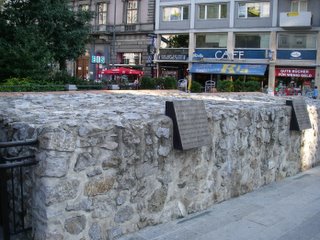
This is a preserved remnant of Vienna's famous walls. Where the walls that ringed Vienna once stood, is now a street, named "Ringstrasse".
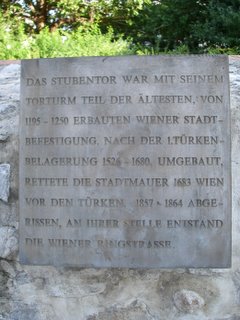
Here's the etching on the wall remnant, with important dates and terms that need no translation: "Turken Belagerung 1526-1680", "1683 Wien vor den Turken".
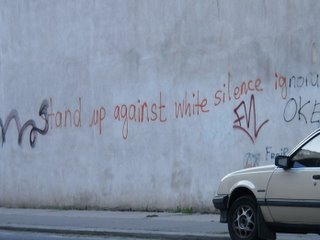
I found this graffitti on a park wall near my hotel. (I suspect these nimrods may be in league with the defacers of other American monuments, but I can't prove it).
Easy, meaningless sentiment; and symptomatic. Its in English, oddly, but it still requires translation.
Subscribe to:
Posts (Atom)

